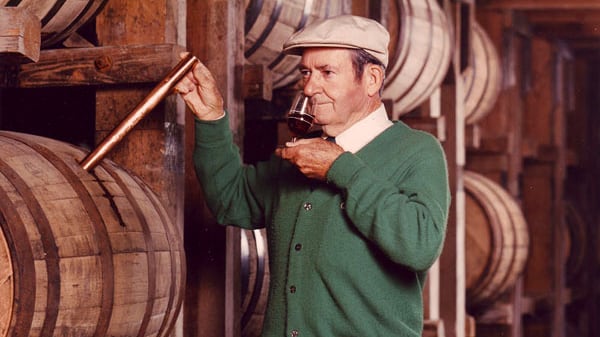One of the keys to the runaway success of single malt Scotch is that it comes from a single distillery and you can’t add anything to it besides water and a bit of spirit caramel to even out the color. That highly regulated purity has struck a chord with consumers around the world who are willing to pay ever-increasing prices for their favorite Glen and have a passion that borders on zealousness.
But there’s actually another type of whiskey, which is held to an even higher set of standards than single malt Scotch: bottled-in-bond American whiskey.
Thanks to a federal law from 1897, a bottled-in-bond (BiB) bourbon or rye must be from one distillery that is identified on the label, the product of a single distilling season, made by one master distiller, aged at least four years in a government bonded warehouse and bottled at 100 proof.
ADVERTISEMENT
The whiskey also needs to meet all the nitpicking specifications for a regular straight whiskey, including that it can only be aged in a new wooden barrel, as well as a lengthy list of other distilling and aging regulations.
Bottled in bond is truly the good stuff, and that is what it was certainly meant to be. In the late 1800s, unscrupulous whiskey rectifiers sold products that were seriously degrading the reputation of bourbon whiskey. These hustlers would buy young whiskey or grain spirits in bulk and then doctor them up with a dismaying range of additives—glycerin, tobacco juice, prune extract and more—to give that “old bourbon” taste. (This was such a common practice that these “whiskey recipes” were even included in popular bartending books of the time.) The adulterated whiskies flooded the market, and the good name of bourbon quickly began to erode.

Some of the prominent bourbon distillers of the day, including Colonel E.H. Taylor, went to Washington to get help. They found an ally in Treasury Secretary John G. Carlisle, who helped to pass the Bottled in Bond Act.
Some brands, however, felt that the act was too restrictive. They wanted to blend whiskies of different ages, for instance, while still being able to label them as pure and straight. The Pure Food and Drug Act, which was passed nine years after the Bottled in Bond Act, tried to address these concerns with its more familiar regulations on what makes bourbon whiskey bourbon whiskey.
As the term “straight whiskey” gained traction, producers de-emphasized their bottled in bond products and the term meant less and less to consumers. It is also cheaper to produce bourbon that isn’t 100-proof, since adding water to it brings down the alcohol content. And in an effort to get more (read: lower-proof and younger) product on store shelves, a number of brands discontinued their bottled-in-bond whiskies after World War II to meet the unquenchable thirst of returning servicemen and women.
Ten years ago there were fewer than 20 bottled-in-bond spirits on the market and the designation no longer meant you were getting the good stuff. In fact, it was now relegated to the bottom shelf, often selling for under $15 a bottle. The price reflected the complete lack of advertising support given these brands and the dearth of demand from consumers.
That was just fine with me. For those of us who liked these 100-proof, younger bourbons and ryes, bottled-in-bond was a happy secret, a solid bargain that everyone else walked right by.
This got even better as the new fans of bourbon rushed to older, rarer bottlings and passed up the younger bonded whiskies that tasted more like bourbon and less like 20-year-old barrels.
The now ubiquitous Rittenhouse Rye, for one, flew under the radar for quite a while, and this great cocktail whiskey regularly sold for under $15 a bottle.
Eventually, of course, word got out and, to my dismay, prices are slowly climbing for these bottled-in-bond whiskies, but they are still underpriced and you can find them for a very reasonable cost.

Just don’t expect the woody bourbons that people have been fawning over. While there are some older bonds, like Henry McKenna at a full 10 years old, most are six years old or less. But there is a lot to be said for a younger bourbon—mainly, that it has a solid, sweet character, a certain rough raunchiness to it that brings the smell of a hot bourbon warehouse to mind.
This is a whiskey that has both the flavor to stand out in a cocktail and the proof to stand up in a glass full of ice. When I’m looking to sip a highball while pondering the world, only a bonded will do.
To help you appreciate these whiskies you need to, of course, try them. Here are a few of my favorites. Just remember, you might have to look on the bottom shelf to find them!
Heaven Hill BiB 6-Year-Old: Look for the white label; there’s a younger Heaven Hill BiB with an old-gold label, but you want this 6-year-old wonder. It’s got that raw, sweet beauty that lets you know you’re drinking bourbon: hot corn, a rough wreathing of oak and solid power. Sometimes you want a punch in the face and this delivers.
Old Grand-Dad BiB: One of my go-to bourbons for years, OGD Bonded is cheap, delicious and bursting with rye spice. It makes a great Manhattan, but it really shines in an Old Fashioned. (The “Grand-Dad” is Basil Hayden, by the way, who gives his name to another Beam bourbon.)
Evan Williams BiB: Heaven Hill has maintained a number of old-label bonded bourbons for years, but this bonded version of their flagship Evan Williams bourbon is new, with a sharp white label and full-bore 100-proof strength. Great on the rocks, but built for full flavor in cocktails, it makes a dangerously good Mint Julep.






